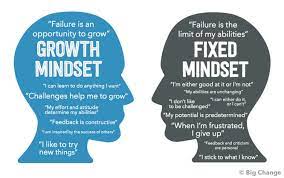“Growth mindset” is a term coined by psychologist Dr. Carol Dweck who discovered in a study that neurological activity changes when people focus on the learning process, not just on the outcome.
What this means is that success at acquiring new knowledge and skills genuinely requires a different mindset. Here’s why this is important for leaders to understand:
What Is a Growth Mindset?
Having a growth mindset essentially means that you believe your skills and abilities can grow over time. At first glance, you may assume that this is what everyone believes but, actually, people with a growth mindset are very different from those with a “fixed mindset.”
Specifically, these are the people more likely to accept the learning process and the mistakes that typically occur during it. Additionally, people with a growth mindset are more likely to learn from their mistakes rather than viewing them as personal or professional failures.
Because, for people who possess a growth mindset, the “reward” of the learning process isn’t solely what motivates them. They are driven by the entirety of the learning, striving, and achievement experience.
Other traits of having a growth mindset include:
- Viewing effort as part of the learning process
- Leading teams with an explicit goal of personal development
- Not refraining from taking risks
- Embracing challenges head-on
By comparison, those without a growth mindset (having a fixed mindset):
- Are less likely to take risks
- May refuse to take on a challenge
- Believe they are or aren’t good at something right off the bat
- Tend to blame themselves when things go wrong
- Feel the need to constantly prove themselves
What Happens When Leaders Shift to a Growth Mindset?
Moving towards a growth mindset can provide leaders with:
- Higher confidence and self-esteem
- More resilience
- The ability to improve their relationships with important constituents
- A positive attitude that can even make more mundane aspects of life and work more enjoyable.
How Can Leaders Shift to a Growth Mindset?
Changing the way you think isn’t easy. But like so many things, you can learn how to shift your mindset and to focus more on growth and the related opportunities.
Some strategies that can help include:
- Work with a leadership coach– If you don’t have a growth mindset yet, a coach can help you build it by providing their support and expertise. In a sense, coaches can be a “growth mindset” voice to help you shift your way of thinking;
- Identify areas for improvement – Self-awareness is key to one’s learning and development; and identifying and accepting your weaknesses are critical aspects of the process. Ensure that you determine why working on your areas of weakness is important, as the benefits of making change (or the consequences of not doing do) are frequently primary motivating factors.
- Let go of the idea of “perfect” – Many of us strive for perfection, but a lot of times it may hold leaders back. The desire for things to come out perfect can keep you from taking necessary risks and even enjoying your position as a leader.
Transitioning to a growth mindset doesn’t happen overnight but, with sustained effort, determination, and patience, you can let go of the limitations associated with having a fixed mindset. And once you do, your abilities as a leader will likely improve tremendously!
Thanks to my friends and colleagues at Kashbox Coaching for sharing this article.

